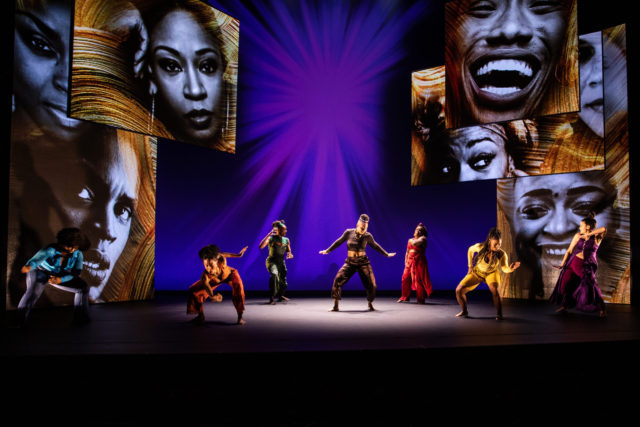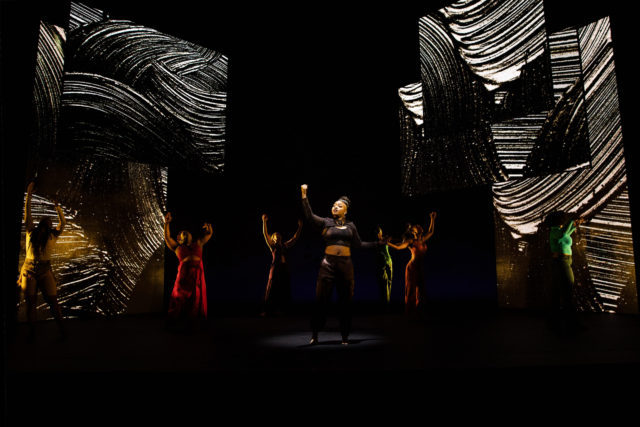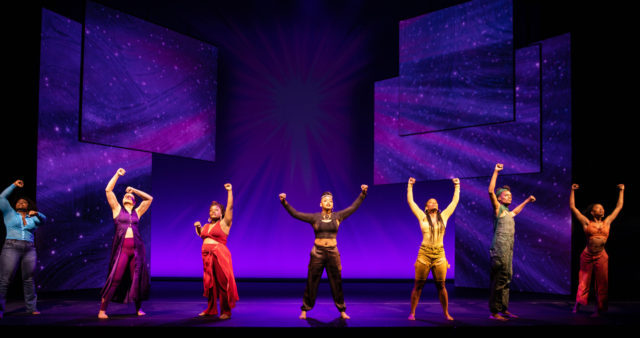
for colored girls who have considered suicide/ when the rainbow is enuf is facing an early closing notice at the Booth Theatre (photo by Marc J. Franklin)
for colored girls who have considered suicide/ when the rainbow is enuf
Booth Theatre
222 West 45th St. between Broadway & Eighth Ave.
Tuesday – Sunday through June 5, $49 – $225
forcoloredgirlsbway.com
As I write this, there is a movement afoot to prevent the first Broadway revival of Ntozake Shange’s for colored girls who have considered suicide/ when the rainbow is enuf from closing early; the show opened April 20 to good reviews and was scheduled to run through August 14, but it was announced a few days ago that it would be leaving the Booth after the May 22 matinee. To help fill seats and keep the choreopoem, in which seven women share intimate stories of misogyny, abuse, and their retaking of power, from shutting its doors, journalists, artists, and theater bigs (Ayanna Prescod, Bebe Neuwirth, Mickalene Thomas, Chita Rivera, Lorin Latarro) have been sponsoring free ticket giveaways to lift the current average attendance, which is barely half capacity. The night I saw it, the audience seemed much larger than that and loved every second of the play, built around a series of monologues with music and dance in between. [ed. note: The show has now been extended through June 5.]
Director Leah C. Gardiner and choreographer Camille A. Brown collaborated on a sensational 2019 revival at the Public, where the original production moved in 1976 after earlier iterations at smaller venues in Berkeley and downtown New York (and shortly before moving to Broadway). Toni-Leslie James’s ravishing costumes featured multiple images of the face of each actor’s most beloved female relative, honoring the ancestors; Myung Hee Cho’s inclusive set was highlighted by three rows of chairs for audience members along the back arch of the circular stage, in front of a large mirror, which reflected the rest of the audience so they appeared right behind the cast; and Jiyoun Chang’s bright lighting often illuminated everyone in the theater. The show has been reimagined and reinvented for the Booth, unfortunately not for the better, but Shange’s striking words are as sharp as ever.
It all begins with a voice-over from Obie-winning, Oscar-nominated poet, novelist, playwright, kids’ book author, activist, and essayist Shange herself — who portrayed Lady in Orange back in 1976 and updated the script in 2010 — offering, “Aunt mamie was a lil colored girl, Auntie Effie was a lil colored girl, Mama was a lil colored girl, you’re a lil colored girl . . . / Imagine . . . if we could get all of them to talk, what would they say? / Imagine all the stories we could tell about the funny looking lil colored girls, and the sophisticated lil colored girls, and the pretty lil colored girls . . . the ones just like you!”

Seven women share their heartbreaking and celebratory stories in Ntozake Shange’s powerful choreopoem (photo by Marc J. Franklin)
Over the course of the next ninety minutes, Lady in Orange (Amara Granderson), Lady in Brown (Tendayi Kuumba), Lady in Red (Kenita R. Miller), Lady in Green (Okwui Okpokwasili), Lady in Blue (Stacey Sargeant), Lady in Purple (Alexandria Wailes), and Lady in Yellow (D. Woods) poignantly relate key moments from their lives, with such titles as “dark phrases,” “no assistance,” “latent rapist,” “abortion cycle #1,” and “i usedta live in the world.” (Okpokwasili and Wailes return from the Public; I saw three understudies: Treshelle Edmond as Lady in Purple, McKenzie Frye as Lady in Orange, and Alexis Sims as Lady in Green.)
Hee Cho’s set is now dominated by a half dozen screens on the left and right, on which Aaron Rhyne’s mostly abstract (and distracting) visuals are projected. Sarafina Bush’s costumes are contemporary street clothing, the colors not as boldly obvious. Chang’s lighting is more standard, and Justin Ellington’s sound is built for the music, which is by Martha Redbone and Aaron Whitby and tends toward light jazz and R&B. Brown is the director and the choreographer, the first Black woman to do both on Broadway since Katherine Dunham for her three-act revue in November 1955.
The Obie, Tony, and Bessie-winning Brown has choreographed for her own company, Camille A. Brown & Dancers, as well as Alvin Ailey American Dance Theatre and such Broadway shows as Choir Boy and Once on This Island; she also choreographed and codirected (with James Robinson) the Metropolitan Opera’s premiere of Terence Blanchard’s Fire Shut Up in My Bones. Her style is rarely subtle, and that can work well in a dance presentation, but in for colored girls it quickly becomes overwhelming; instead of giving agency to the characters, it takes away from the narrative. Perhaps Gardiner was a calming influence; her deft touch is missing from this version.

for colored girls who have considered suicide/ when the rainbow is enuf is the first Broadway show to be directed and choreographed by a Black woman since 1955 (photo by Marc J. Franklin)
The cast is terrific, with an especially superb turn by the pregnant Miller, who thrillingly delivers “no assistance,” ending an affair with a lover (“this note is attached to a plant / i’ve been waterin since the day i met you / you may water it / yr damn self”), and “no more love poems #1” (“this is a requium for myself/ cuz I have died in a real way/ not wid aqua coffins & du-wop cadillacs/ i used to joke abt when i waz messin round / but a real dead lovin is here for you now/ cuz i dont know anymore/ how to avoid my own face wet wit my tears/ cuz i had convinced myself colored girls had no right to sorrow”).
The centerpiece is Lady in Green’s “somebody almost walked off wid alla my stuff,” in which she fights for her own being, for who she is and what is hers. She declares, “somebody almost walked off wid alla my stuff / not my poems or a dance I gave up in the street / but somebody almost walked off wid alla my stuff / like a kleptomanic working hard & forgettin while stealing / this is mines / this aint yr stuff / now why don’t you put me back & let me hang out in my own self.”
Despite the shortcomings of this production, for colored girls deserves a longer life on Broadway, telling an important story that particularly needs to be heard as Roe v. Wade is under fire and a woman’s right to her own body is threatened by a white patriarchy trying desperately to hold on to its fading power. It’s a truly American story; the characters hail from outside Atlanta, Boston, Brooklyn, Chicago, Detroit, L.A., and Newark, cities that have faced racial violence. It seems clear they’ve had enough and that the lives of women, and specifically women of color, would be different if they were in charge.